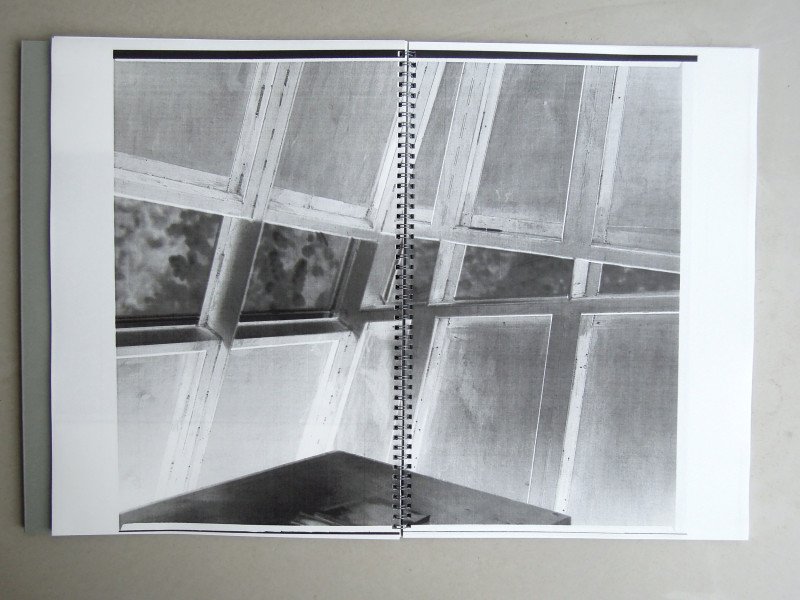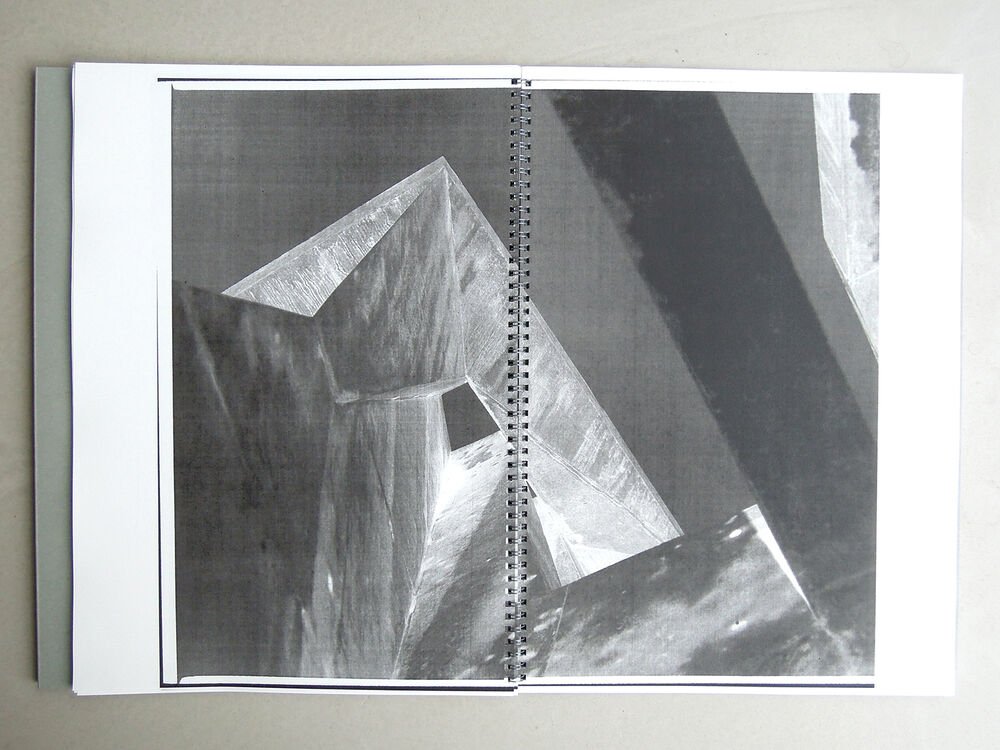Joachim Brohm Stones BR-ED 78 Signed and Numbered Copies
-From American Suburb X
With Stoned, the recent artist book publication by eminent German artist Joachim Brohm, in conjunction with editor and collaborator Alexander Rosenkranz, the Domenig Steinhaus becomes an exercise in graphism. I specifically use that term because, with the intervention of Brohm’s color images reverted to monochrome inversions, the images take on something closer to a drawing than a photograph. This is intentional, as it gives the impression of Domenig Steinhaus’s material value, namely the grey sludgy concrete that performs the angles and gravity alike. The images are reduced to an unruly and uncanny symmetry. This is also due to Rosenkranz’s use of a photocopy machine to produce the extensive oversized results. The wire bind of the book reminding one of the Arts Metiers Graphiques books from the 1930s, giving the impression of something approaching a functional manual or retaining a book object that presents utility in binding choice over that of the standard issue OTA bind prevalent in other books that crossover between photography and architecture, the reason being to keep the photographic image intact. Here, the wire binding sutures the two halves of the building together in a form that inherently refers to material. It is a utility choice, but it also enables the book to be read as much for the content as for the design and production.
Stoned
Edited and printed by
Alexander Rosenkranz
on Konica Minolta Bizhub 220
Large-sized zine:
42 x 30 cm, 80 pages, O-Wire binding
Design: Heike Nehl, Moniteurs, Berlin
Scans: Mateusz Dworczyk, Fotohof > Archiv, Salzburg
Binding: Heiko Marré, Petersberg
Published by BR-ED, Leipzig 2024
Edition of 78 copies, each signed and numbered
-From American Suburb X
With Stoned, the recent artist book publication by eminent German artist Joachim Brohm, in conjunction with editor and collaborator Alexander Rosenkranz, the Domenig Steinhaus becomes an exercise in graphism. I specifically use that term because, with the intervention of Brohm’s color images reverted to monochrome inversions, the images take on something closer to a drawing than a photograph. This is intentional, as it gives the impression of Domenig Steinhaus’s material value, namely the grey sludgy concrete that performs the angles and gravity alike. The images are reduced to an unruly and uncanny symmetry. This is also due to Rosenkranz’s use of a photocopy machine to produce the extensive oversized results. The wire bind of the book reminding one of the Arts Metiers Graphiques books from the 1930s, giving the impression of something approaching a functional manual or retaining a book object that presents utility in binding choice over that of the standard issue OTA bind prevalent in other books that crossover between photography and architecture, the reason being to keep the photographic image intact. Here, the wire binding sutures the two halves of the building together in a form that inherently refers to material. It is a utility choice, but it also enables the book to be read as much for the content as for the design and production.
Stoned
Edited and printed by
Alexander Rosenkranz
on Konica Minolta Bizhub 220
Large-sized zine:
42 x 30 cm, 80 pages, O-Wire binding
Design: Heike Nehl, Moniteurs, Berlin
Scans: Mateusz Dworczyk, Fotohof > Archiv, Salzburg
Binding: Heiko Marré, Petersberg
Published by BR-ED, Leipzig 2024
Edition of 78 copies, each signed and numbered
-From American Suburb X
With Stoned, the recent artist book publication by eminent German artist Joachim Brohm, in conjunction with editor and collaborator Alexander Rosenkranz, the Domenig Steinhaus becomes an exercise in graphism. I specifically use that term because, with the intervention of Brohm’s color images reverted to monochrome inversions, the images take on something closer to a drawing than a photograph. This is intentional, as it gives the impression of Domenig Steinhaus’s material value, namely the grey sludgy concrete that performs the angles and gravity alike. The images are reduced to an unruly and uncanny symmetry. This is also due to Rosenkranz’s use of a photocopy machine to produce the extensive oversized results. The wire bind of the book reminding one of the Arts Metiers Graphiques books from the 1930s, giving the impression of something approaching a functional manual or retaining a book object that presents utility in binding choice over that of the standard issue OTA bind prevalent in other books that crossover between photography and architecture, the reason being to keep the photographic image intact. Here, the wire binding sutures the two halves of the building together in a form that inherently refers to material. It is a utility choice, but it also enables the book to be read as much for the content as for the design and production.
Stoned
Edited and printed by
Alexander Rosenkranz
on Konica Minolta Bizhub 220
Large-sized zine:
42 x 30 cm, 80 pages, O-Wire binding
Design: Heike Nehl, Moniteurs, Berlin
Scans: Mateusz Dworczyk, Fotohof > Archiv, Salzburg
Binding: Heiko Marré, Petersberg
Published by BR-ED, Leipzig 2024
Edition of 78 copies, each signed and numbered




